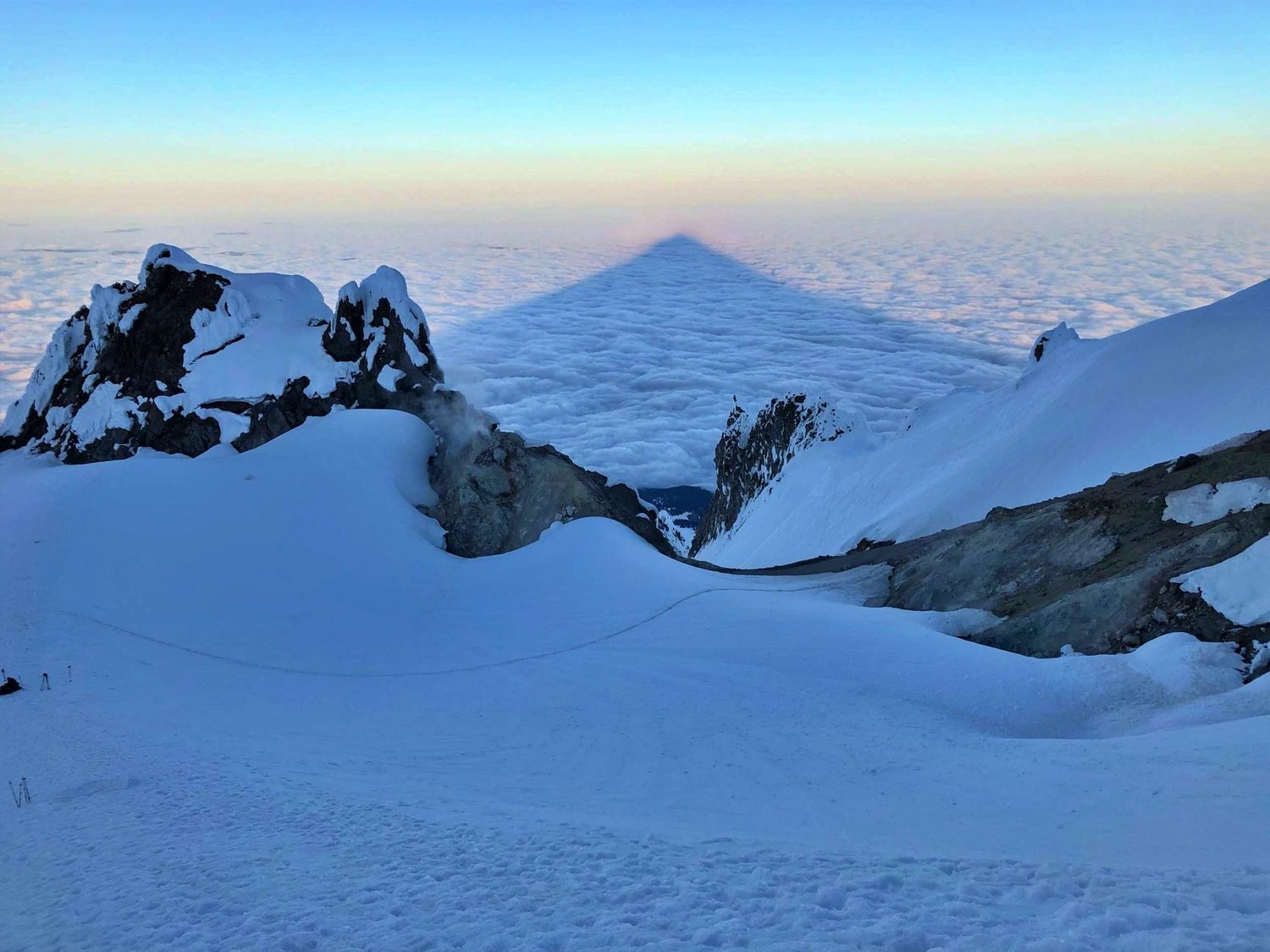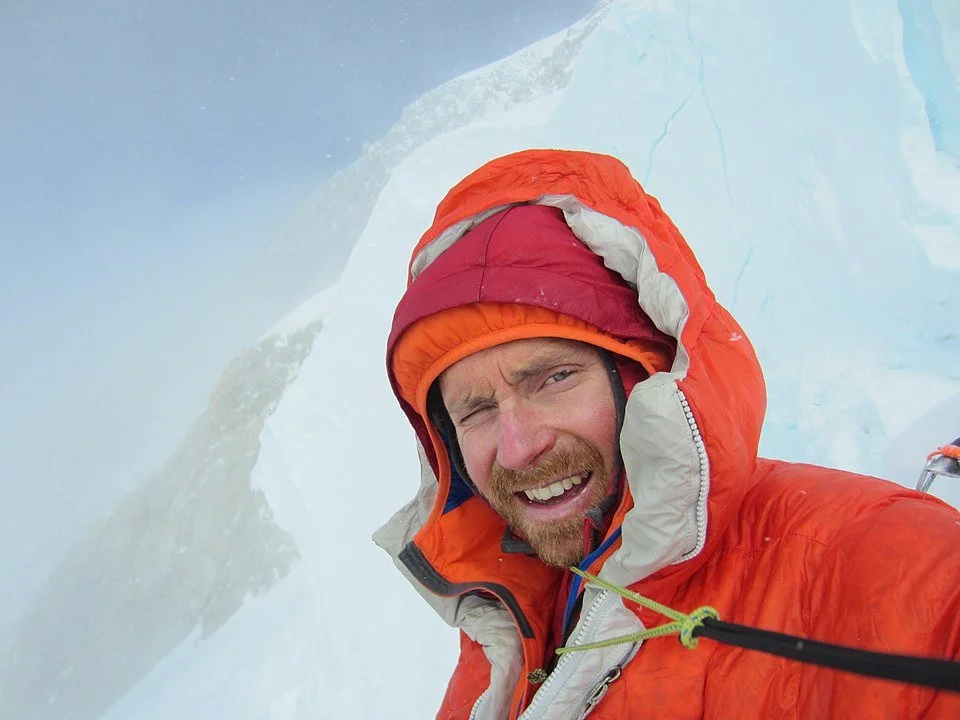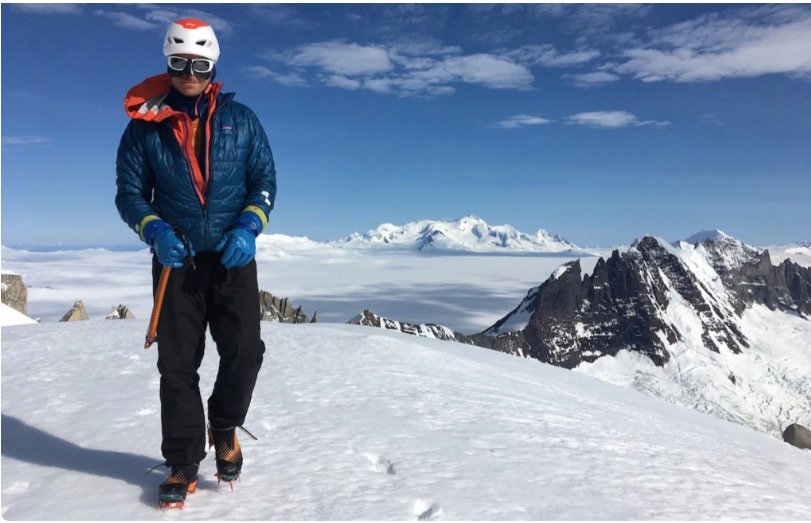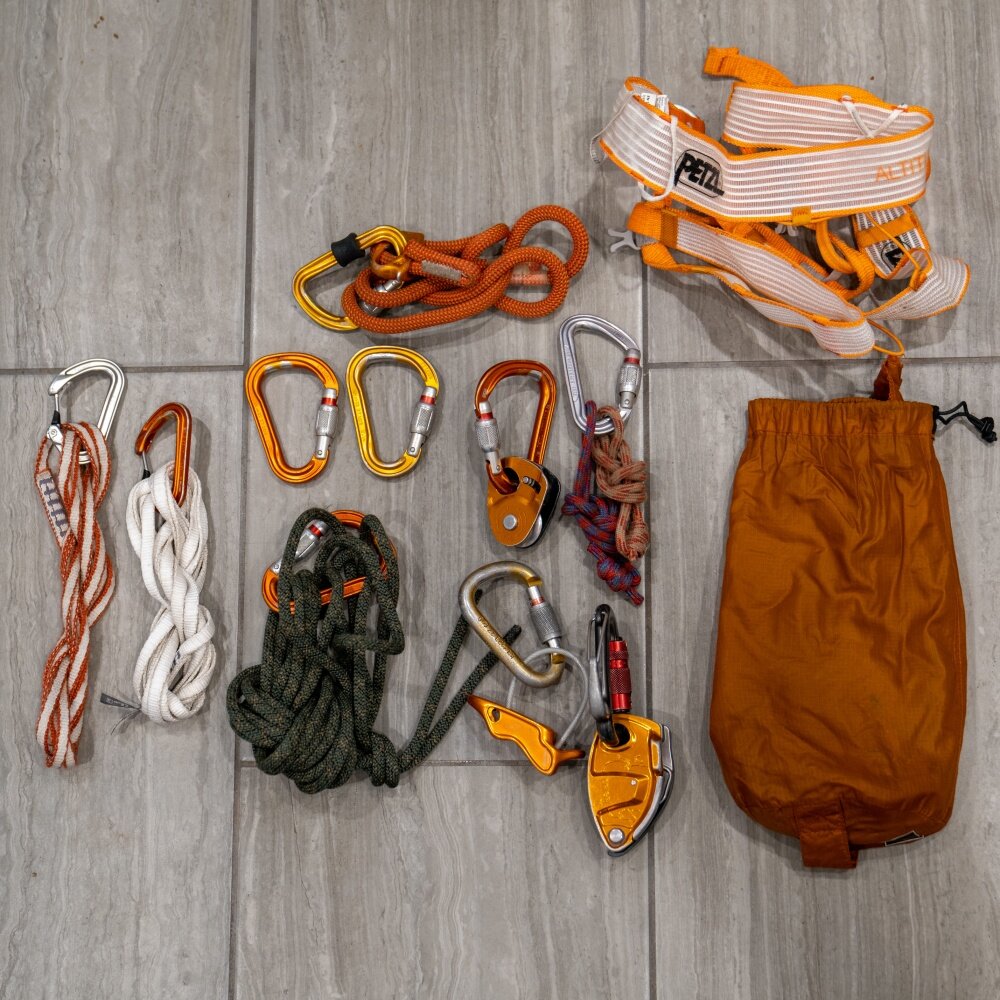
Alpine Tips
What's in my pack: Gear obsession by Colin Haley
Expert American alpinist Colin Haley is known for a few things: an expertise for routes in Patagonia, and a tremendous obsession with climbing gear. Check out this great video interview where he offers a free ranging commentary on equipment he’s designed, customized, and uses regularly.
Premium Members can read the entire article here:
I have another “What's in my pack” article featuring Colin, about his clothing systems. You can check that out here.
Check out this great interview with American alpinist Colin Haley, as he takes a deep dive into his obsession with climbing gear.
The link to the YouTube video is below.
Here are a few quotes and highlights I thought were especially interesting.
I added a time stamp for the video so you can find that part fast.
“I personally tweak out about climbing gear to a very small level of detail." =^)
“There are trade-offs to everything. Every gear choice is maximizing some quality at the expense of some other quality.”
What piece of alpine climbing clothing did Colin have a big role in designing for Patagonia? (M10 pant, 18:00)
Colin often wears a hard shell pant and a soft shell jacket on his climbs, which is the exact opposite of most people. Why is that? (Because it's more common for your butt to be in the snow than your torso. 19:50)
What’s the small Slovenian company that makes some of Colin's favorite functional and low-cost pitons? (climbready.eu, 20:15)
What's Colin's favorite old-school bit of tech for listening to “mountain motivator” music on a route? (Ipod Shuffle, 23:50)
Why is a top quality headlamp such a crucial piece of gear? (Colin calls is the “1 essential,” because it lets you keep pushing on when it gets dark, to maybe find a much better place to bivy. If you don't have a good headlamp, you’re stuck as soon as it gets dark. 51:30)
The complete article has answers and time stamps to these questions:
What are the pros and cons of internal tent sleeves versus external?
What are some considerations for choosing the correct crampons?
What’s a simple way you can keep your tent from blowing away when you're out climbing?
What's the one type of climbing gear that Colin thinks has the most potential for improvement?
What’s a clever modification Colin did to his helmet to make it more suitable for cold weather climbing?
What modification did Colin make to his crampons that he really likes?
What's Colin's favorite water bottle?
Which climb did Colin learn the most from?
Get the answers to all these, and the time stamps to the video for each one . . . and the link to the video itself at the Premium Member article.
Join my Premium Membership to read the complete article.
Thanks for your support.
What's in my pack: big wall gear by Brent Barghahn
Pro climber Brent Barghahn has some impressive free climbing ascents of El Capitan, and definitely knows a thing or two about what to bring on a big wall. Here's a link to his checklist from a helpful blog article he wrote.
Premium Members can read the entire article here:
Brent on a crux section of El Corazon, El Capitan. Image: https://www.brentbarghahn.com/climbing-blog/el-corazon-ground-up-2022crux
Brent Barghahn, professional climber and humble bad-ass, knows a thing or two about big walls. He has some very impressive free ascents on El Capitan, such as El Corazon, El Nino, and Golden Gate.
He’s also an innovator of climbing gear, much of it for lead rope solo and top rope solo. Check out his company, Avant Climbing.
You can read some detailed stories of his climbing adventures on his blog.
One of his blog posts is a collection of general big wall tips.
The big wall tips are excellent. Many of them you'll find on the Alpinsavvy big wall section, such as:
using a tagline, among others.
In addition to the expert tips is Brent’s schweeeeet gear checklist. Attention to detail is crucial on a big wall, and a solid checklist like this will help you bring most everything you need.
(Yes, it's mostly focused on free climbing, which is beyond the skill level for most of us plodders, but it's still very useful for aid climbing.)
Alpinesavvy Premium Members get a direct link to the gear checklist. If you're not a Premium Member, you'll have to go to Brent’s blog at the link above and click through and find it yourself. My Premium Member article also has a link to a longform video with an interview with Brent and discussion of top rope solo and lead rope solo techniques.
What's in my pack: alpine climbing gear with Graham Zimmerman
Check out what American alpinist (and Piolet d’Or winner) Graham Zimmerman brought on a highly technical climb of Link Sar in Pakistan. Also, his new memoir is terrific, as is a YouTube film documenting this climb.
Premium Members can read the entire article here:
Connect with Graham on his website and on Instagram, @grahamzimmerman
American alpinist (and Piolet d’Or winner) Graham Zimmerman has an impressive record on big expeditions to many corners of the world. He obviously pays great attention to his gear.
Here's a video of him going through some equipment he used on a highly technical climb of Link Sar in Pakistan in 2017.
Check it out for some tips that might help you on your next outing, even if it's a more modest objective.
Want to see the link to Graham’s video?
Join my Premium Membership to read the whole article.
Thanks for your support!
What's in my pack: ski touring gear by Graybird Guiding
What does a pro ski guide take for a day tour? Check out this detailed list from Shane Robinson and Graybird Guiding.
This post come from Shane Robinson and Graybird Guiding, a Seattle based guide company that not only leads some sweet ski trips, but also has an Instagram full of solid tips. Connect with them at their website and on Instagram. Check out their hashtag #sknowmore for specific backcountry ski tips.
In the pack:
Mountain Hardware 40 liter pack. It’s big enough for a full guide kit or bigger ski mountaineering objectives but can compress down for more average days. Bonus: helmet fits inside most days.
trauma kit (cpr & extreme bleeding) separate from first aid kit and more accessible
general first aid kit
Alpine Threadworks rescue sled & bivy
downhill gloves
headlamp
puffy coat for added warmth or as an emergency layer
Trew Gear Anorak shell
extra buff
helmet
goggles
extra wool hat
thermos for hot water/tea
rescue shovel
probe (ideally 300cm long)
Leatherman multi-tool
sunscreen & lip balm
snow saw, with teeth that can also cut wood if needed in an emergency (not pictured)
Garmin InReach (not pictured)
cordelette, double length sling, and a couple carabiners (not pictured)
Actually wearing:
hat with visor
sunglasses
avalanche transceiver
What's in my pack: clothing systems by Colin Haley
American alpine climbing expert Colin Haley has some battle-tested (and somewhat unconventional) preferences for his alpine clothing system. See a few of them here, along with the link to the complete article on the Patagonia website.
Colin Haley on the summit of Cerro Domo Blanco. photo by Alex Honnold. from https://www.patagonia.com/stories/colin-haleys-clothing-system-for-alpine-climbing-in-the-chalten-massif/story-95145.html
American alpine climbing expert Colin Haley gives a LOT of thought and serious field testing to his alpine clothing system. The Patagonia website has a superb deep-dive article that covers a lot of Colin’s clothing choices, some of them quite unconventional.
In case that goes away, here’s a PDF saved on my Google Drive.
For me, here are a few takeaways from this excellent article.
“At any given moment in time, I must be able to wear every item of clothing that I brought with me on a climb (the exceptions to this rule are gloves and socks). The total insulation value of all my layers worn at once must be great enough for the environment I’m climbing in. A good rule of thumb for myself is that if I bring enough clothing to be comfortable for all planned circumstances (while belaying at night, for instance), then I’ll have enough warmth to make it through an unexpected circumstance, like an unplanned open bivouac. I wouldn’t by any means be comfortable, but I would feel safe from hypothermia.”
“Highly technical climbing requires a very large range of motion (much more than trail running or skiing, for instance), and the ideal clothing system is the one that hinders that movement the least. Your clothing system should not only allow you to have full range of motion, but it should do so without wasting energy. For example, many soft-shell pants allow you to highstep, but you have to dramatically stretch the fabric every time that you do, and when you add up the thousands of times over the course of a big alpine climb that you highstep, you are wasting a lot of energy repeatedly stretching that fabric.”
“When the wind gets strong (as it tends to do in high mountains, especially in Patagonia), not having an outer layer to block the wind drastically reduces the insulation value of the rest of your clothing. Whether or not you need a waterproof layer depends on the environment and circumstances in which you’re climbing. In a really cold environment, like on Denali or on 8,000-meter peaks, a waterproof layer is usually superfluous. In a place where the temperature often fluctuates right around freezing, a waterproof layer can be very important. Wind protection is essential in any high-alpine environment, and water protection might be important or might not be.”
“Rather than bringing a heavier, warmer puffy, my preferred system is usually to bring two Micro Puff Jackets. When it’s warm, they’re both in my pack. When it’s chilly I wear one, and when it’s cold I wear both of them. I used to bring one in size S and one in size M, but I realized more recently that I prefer to bring both in size M. The baggier fit gives me better freedom of movement when climbing.”
“The Houdini jacket is, in my opinion, the single most useful, important item of clothing that I own. It is very simple: just an incredibly lightweight windbreaker.”
The Nano-Air vest has become one of my favorite items of clothing in the past couple of years. I find that a vest is often a great way to slightly boost the total insulation of a clothing system. Because a vest covers your torso it makes a significant difference to how warm you feel. Because a vest doesn’t cover your arms, it doesn’t affect freedom of movement much, and is thus well suited to technical climbing.
“I used to nearly always get my jackets in the hooded version. More recently, I have decided that I prefer to have fewer hoods. The way I see it, if you can’t comfortably wear all of your hoods at the same time, then clearly you have too many! These days I prefer to have a bit more insulation directly on my head (often two balaclavas at once—see below), and only a couple of hoods. I feel that I have an easier time moving my head around this way.”
“Recently, I have been using a system of two balaclavas: one is a very thin silk-weight, and the other is thicker and warmer. Unless it is really warm out, I wear the silk-weight balaclava for essentially the entire climb. It adds a bit of warmth and protects my ears and neck from the sun. Between my helmet, the silk-weight balaclava and my sunglasses with nose-guard and cheek-guards, I pretty much don’t have to use sunscreen at all, except on my lips. Whenever it gets colder, I put the thermal-weight balaclava on over the silk-weight one, and together they both fit comfortably under my helmet.”
“Contrary to what many beginners might think, in a given pair of boots your feet will almost always be warmer in thinner socks, and colder in thicker socks. If your socks are too thin, then your boots will be too loose, and the climbing performance will be diminished. If your socks are too thick, your circulation will be reduced, and your feet will be cold.”
What's in my pack: Rainier gear by Mark Smiley
Check out what IFMGA Certified Guide Mark Smiley takes for a two day Rainier climb up one of the standard routes. (This is a free preview from Mark's new online class class on alpine climbing. Learn more from his website, mtnsense.com.)
This gear list is a free excerpt / preview from Mark's new online course, “The Ultimate Guide to Modern Alpinism”. I haven’t taken it, but I have taken a couple of his other online courses, and they were excellent. Check out all of Mark's offerings at mtnsense.com.
Emmons Glacier, Mt Rainier. Photo by Vaqas Malik
There’s nothing a gearhead likes more than a detailed packing list from an expert climber. Here’s what IFMGA Certified Guide Mark Smiley likes to pack for a two day Mt. Rainier trip up one of the standard routes (Emmons or Disappointment Cleaver). (I've climbed Rainier several times and sure wish I had a few things on this list.)
Of course you don't have to bring everything listed, but it's a pretty good starting point.
Clothes
Wool t-shirt
Sun hoodie
Thin wind shell
Light puffy
Big puffy
Waterproof shell jacket
Buff
Hat with visor for sun protection
Thin gloves for hot day on glaciers
Showa Temres gloves for cold and wet
Second pair of cold-weather gloves (if forecast is for nastiness)
Softshell pants
Waterproof pants
Socks
Boots (Single layer, with integral gaiter)
Climb gear
Helmet
Sunglasses
Goggles
Headlamp (400 lumen minimum)
Lightweight harness (Edelrid Prisma Guide)
Steel crampons (Mark likes the CAMP Skimo Pure Nanotech crampons, very lightweight)
Ice Axe (50 to 70 cm)
Trekking poles
One mid clip picket
One ice screw (aluminum, 16 or 19 cm)
Petzl Nano Traxion progress capture pulley
Petzl Tibloc
Four lightweight carabiners
Three locking carabiners
Two 120 cm Dyneema slings (or cordelette)
Rope (50 or 60 meters, 8.4 mm dry treated)
Avalanche transceiver
Shovel
Avalanche probe
Pack and camping gear
55 liter pack
2 liter water bag
Steripen water purifier
Lip balm (several tubes)
Sunscreen (small tube or stick)
Satellite communication device
Backcountry navigation app, with GPX file of route loaded onto phone
First aid kit
Sleeping bag (down, 20 degrees)
Compression stuff sack
ThermaRest NeoAir XLite Sleeping Pad
Compact pillow
Two person mountaineering tent
Earplugs
Canister stove (MSR Reactor or Windburner, not Jetboil)
One freeze dried dinner and one breakfast
Spoon
Lunch food, whatever works for you
What's in my pack: Denali gear by Mark Postle and Steve House
Mark Postle and Steve House have more then 30 Denali summits between them, and so they know what gear works and what doesn’t. Check out these videos, and accompanying article from Uphill Athlete, to learn the precise kit they like to bring.
Steve House and veteran guide Mark Postle have more then 30 Denali summits between them. Learn what Denali gear they like (and don’t like) in this article and in two videos from Uphill Athlete.
They review pretty much every piece of gear, naming exact brands and models. What do they cover?
What temperature rating sleeping bag should you bring?
Why are baby wipes (usually) a bad idea?
Do you need gaiters? How about a headlamp?
How much sunscreen should you bring? (Hint, not much)
What's the best size and shape of duffel bag to go on your sled?
Who’s the most important person to make friends with when you land at base camp?
Pro tip: At camp, remove your liner boots, put on your down booties, and then put your foot in your outer boot to wear around camp.
Pro tip: if you’re wearing puffy pants, you can unzip the fly and clip the rope to your belay loop through the fly.
You get the idea - loads of tested expert tips! (Plus, a pretty long list of things you should not bring.) If you're headed to Denali, have a look.
Here's a video covering clothing and personal gear with Mark, about 45 minutes.
Here's a longer video/podcast version on the same topic, with additional expert advice from Steve House, about 2:12.
And finally, here's the original article at Uphill Athlete, with a summary of the gear list.
What's in my pack: rescue gear by Karsten Delap
A search and rescue (SAR) team may head out on a mission without knowing what they might be getting into. Carrying some carefully selected gear can help you be resourceful and adapt to a mission that might be more technical than you initially thought. This article comes from rescue expert and IFMGA Certified Guide Karsten Delap.
Say you’re on a search and rescue team. You probably have a “go pack” already loaded with the essentials of food, clothing, headlamp, first aid etc., but what about technical gear?
If your callout for a mission involves steeper terrain, having a small prepackaged kit of technical equipment can help you deal with unexpected contingencies. If everyone on your team carries something similar, this gives you lots of room to be resourceful and create more advanced lowering and raising systems if necessary.
Here’s what rescue expert Karsten Delap carries for those missions when you don’t quite know what you might be getting into.
Petzl Altitude Harness (The Petzl Tour harness is a bit cheaper and only a little heavier)
Petzl Connect Adjust personal lanyard
Petzl GriGri
Petzl Micro Traxion
Petzl Reverso (plaquette style device) with round stock carabiner
4 locking HMS carabiners
2 non-locking carabiners
two 5 mm prusik loops
120 cm sewn sling
180 cm sewn sling
21 feet 7 mm cord
small stuff sack to hold everything
Want to learn more about why Karsten chooses this specific kit, and what each item can be used for?
What’s in my pack: backcountry ski kit by Colin Zacharias
Have a look what backcountry ski expert and IFMGA Guide Colin Zacharias carries for a day trip in this excellent YouTube video. (You'll never guess what the wine corks are for . . .)
I love “what’s in my pack” style videos (or second best, reading an article) by real experts.
Here’s an excellent one from Colin Zacharias. Colin is an Association of Canadian Mountain Guides (ACMG) and IFMGA certified guide, who has been ski guiding for decades. His gear is dialed, comprehensive, and fits nicely in a 30 liter pack.
Of course everyone will take away different things from a video like this, but here are a few cool tricks that were new to me.
How to use wine corks (?!) to make a rescue sled
Get a snow saw that can do double duty as a wood saw
Some specialized first aid gear for leg injuries more common with skiers
Check out the video link below to help get your ski gear dialed in.
What's in my pack - alpine climbing by Steve House
It's a rare opportunity to hear from a world class expert on what specifically they bring for an overnight alpine climb. Get it straight from Steve House. (You’ll never believe what he fits in a 30 liter pack!)
Connect with Steve and learn cutting edge alpine training at his website, uphillathlete.com
Want to know what a world class alpinist takes for an overnight climb? Watch this great YouTube video as Steve House explains his detailed gear choices. You’ll be amazed at all of the gear he manages to fit in a 30 liter pack!
Some key points:
Food: pretty much energy bars
No Camelbacks or water bladders. Steve uses 600 ml soft flask collapsible water bottles. Carry no more than one liter total, because water is heavy. Put the flask in a mitten to insulate it if it's really cold, and try to always start off with hot water. He has a dilute electrolyte mix already in the water
When you get to your bivy, first thing to eat is some nuts (almonds cashews, raisins). Also, have some sort of recovery drink mix like Roctane. You want carbs, amino acids, and electrolytes in the recovery drink
Tries to avoid heating too much water, like for soup or tea, because that means you need to bring more fuel
Dinner: freeze dried food. 1 bag per person, 800 calories. Pour in boiling water, put it inside your jacket to stay warmer
Breakfast: instant coffee, 10 g protein powder, energy bar. Keep the energy bar in your sleeping bag so it's not frozen in the morning
Stove MSR Windburner. One small canister can last two people for one day, if you’re careful. Brings an extra foil windscreen for the stove. Generally does not use a hanging stove
Branched-chain amino acid tablets and electrolyte tablets to eat with dinner, for recovery
Gloves: up to four pairs of gloves! Take mittens, belay gloves, lightweight action gloves
Outer shell jacket: Patagonia Houdini if weather is good, Patagonia M10 if it’s going to be colder or windy
Patagonia hyper puff belay parka
Navigation: Garmin InReach, Garmin GPS, paper map in plastic bag, altimeter watch
Sleeping bag: one night trips always bring down bag, more than one night, almost always bring synthetic bag. (Exception, long expedition style climb like Denali when you’ll have the chance to dry out your down bag.)
Always keep a pair of dry socks stored in the sleeping bag. When you’re ready for bed, take off your damp/wet socks, put them on your chest to dry them, and put on the dry socks to sleep. In the morning, swap them, repeat for many days
Sleeping bag get stored inside the bivy sack, and not in a compression stuff sack
Neo air sleeping pad, folded up and put it inside the sleeve inside the pack; this can keep it from getting punctured
Take a 4‘ x 8‘ very lightweight nylon tarp, to string up over his bivy sack
Backpack: 30 Liter Patagonia Ascensionist
Put a trash compactor bag inside your entire backpack, and pack everything inside of that to keep it waterproof























